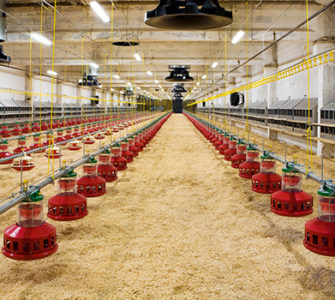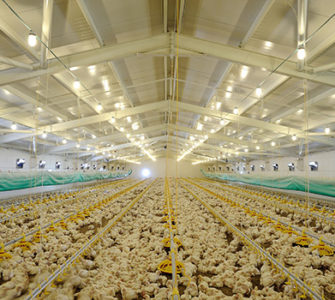NAE producers need to focus on Eimeria oocysts for more effective control of coccidiosis, necrotic enteritis
By Don Waldrip, DVM
Senior Technical Service Veterinarian
Zoetis
Poultry producers raising broilers for the “no antibiotics ever” (NAE) market continue to find themselves battling necrotic enteritis (NE). Too often, this raises the ethical dilemma of deciding whether to render antibiotic treatment to birds with NE if the company doesn’t have a fallback option for medicated birds.
This difficult situation underscores the need to focus on controlling Eimeria oocysts to prevent coccidiosis, which goes hand in hand with NE.
Program options
Coccidiosis vaccination has grown tremendously in recent years. If this is your coccidiosis-control method of choice, do whatever you can to ensure good results. For instance, increased light intensity at the hatchery after coccidiosis vaccination and prior to farm delivery should encourage preening and ingestion of vaccinal oocysts.
Some producers are finding it helpful to follow the initial vaccine with a field boost sprayed on litter or feed.
Another approach is to use coccidiosis vaccination during warmer weather, when there’s generally less coccidial pressure, and then switch to non-ionophore anticoccidials during colder months.
A third option for NAE-production schemes is the so-called bio-shuttle program, where either in ovo or day of age vaccination is followed by a non-ionophore anticoccidial administered. Controlled studies show this hybrid approach can reduce the incidence of coccidiosis in NAE birds, which in turn leads to fewer NE lesions, less mortality and better feed conversion.[i] Timing of the medication is vitally important so it’s a good idea to enlist input from your flock veterinarian, who can help devise the best plan of action. If the anticoccidial is administered too soon, it will kill the vaccine’s coccidial oocysts before they cycle and birds won’t develop the necessary immunity. On the other hand, if the medication is administered too late, Clostridium infection may develop, leading to NE.
NAE producers who don’t use coccidiosis vaccines must rely solely on non-ionophore anticoccidials. With so few options in the toolbox, it becomes even more important to closely monitor the situation with regular posting sessions.
Another useful tool is anticoccidial-sensitivity testing, or AST. Monitoring enables strategic production selection and rotation, which will help preserve the efficacy of anticoccidials. Access to AST has become a bit difficult and may be considered costly for smaller producers, but when possible, I highly recommend it be practiced strategically.
Bird size matters
NAE producers growing smaller birds may find they need to rotate non-ionophore anticoccidials more often for the simple reason that farms processing birds after 5 to 6 weeks have more frequent cycles of exposure to disease agents than operations growing birds to 8 to 10 weeks.
Nevertheless, NAE farms producing large birds have challenges of their own. On those operations, birds may outlive immunity acquired from the vaccines they get at an early age against Newcastle disease, infectious bursal disease, infectious bronchitis and reovirus. The result can be an increased susceptibility to the pathogens. This is one reason why recombinant vaccines have become more popular — they offer long-lasting protection.
Seasonal impact
In warmer months, increased ventilation leads to lower coccidial pressure and better litter quality, so this is a good time for NAE producers to consider either vaccination or a bioshuttle program. Not every medication is suitable for year-round use, however. For example, nicarbazin is associated with heat stress, especially when administered at high dosages.[ii] It’s therefore important to limit its use to the cooler months.
At the other extreme is winter, when farms need to reduce air flow to save on energy costs, and flocks have higher exposure to disease agents. Wetter litter can also accelerate the sporulation of coccidial oocysts in the house and make flocks more susceptible to both coccidiosis and NE. For these reasons, it’s critical to ramp up control efforts and develop a long-term rotation strategy involving all available NAE tools.
Track and monitor
Although long-term planning for coccidiosis control is always a good idea, your program’s real-time effectiveness should be assessed routinely to make sure adjustments aren’t needed. Posting sessions as well as bird performance will be helpful in this regard. Coupling this information with historical data on necropsy results and flock performance for the past 1 or 2 years helps determine product efficacy and can be used to make better product choices.
One important reason real-time effectiveness should be monitored by routine necropsies is due to coccidial leakage, which occurs when some Eimeria oocysts survive flock treatment with non-ionophore anticoccidials. In conventional broiler flocks treated with ionophores, leakage leads to the development of immunity against coccidiosis in chickens. Leakage also occurs in NAE flocks treated with non-ionophore anticoccidials, but it’s turning out to be more difficult to manage. One exception may be zoalene, which is a non-ionophore anticoccidial that works similarly to an ionophore and can be a good choice for bio-shuttle programs.
The amount of leakage that occurs varies with products and their length of use. It’s taking the industry some time — as well as trial and error — to learn how to manage coccidial leakage in NAE flocks, but necropsies to monitor the intestinal status of birds can signal the need for intervention and remedial action.
Wrapping up
Much research is underway to explore the potential efficacy of alternative products for coccidiosis control, such as prebiotics, probiotics, oils and botanicals. Although some antibiotic alternatives have been shown to reduce coccidial-oocyst production, results in the field are inconsistent, and none has proved to be the “silver bullet” that NAE producers have sought. Research and field experience with the alternatives may lead to an effective way to control coccidia without medications, but such a development is unlikely in the immediate future.
For now, producers need to pick the right products based on cost and product performance to guard against losses, preserve what we have available for long-term use and avoid the need to make difficult ethical decisions regarding animal welfare.
Do not use zoalene in laying birds.
1 Da Costa M, et al. Effects of various anticoccidials as bio-shuttle alternatives for broilers under a necrotic enteritis challenge. 2017 Abstracts, International Poultry Scientific Forum. Atlanta, Georgia. M43, page 13.
2 Da Costa MJ, et al. Performance and anticoccidial effects of nicarbazin-fed broilers reared at standard or reduced environmental temperatures. Poult Sci. 2017 Jun 1;96(6):1615-1622.
All trademarks are the property of Zoetis Services LLC or a related company or a licensor unless otherwise noted.
©2022 Zoetis Services LLC. All rights reserved. ZOA-00005
Editor’s note: The opinions and advice presented in this article belong to the author and, as such, are presented here as points of view, not specific recommendations by Poultry Health Today.
Posted on December 6, 2022

















